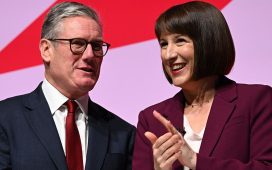Women “work for free for nearly two months” a year, according to fresh analysis which reveals a 15% gender pay gap that widens “dramatically” after women have children.
Women in paid employment earn on average £29,684 a year, compared with the £35,260 a year earned by men, according to the analysis of official data by the Trades Union Congress (TUC).
The TUC said this meant women, on average, effectively work for free for 54 days.
Jeremy Hunt is under pressure to fund more free childcare in his budget on March 15, amid growing evidence that a chronic worker shortage – exacerbated by mothers being priced out of the workplace – has helped fuel inflation. However, the chancellor is believed to have rejected an option of extending 30 hours of free childcare to one- and two-year-olds in England on cost grounds.
The unions’ umbrella body declared on Thursday – the 54th day of the year – to be “Women’s Pay Day” and is demanding the government do more to force companies to close the gap.
“Working women deserve equal pay. But at current rates of progress, it will take more than 20 years to close the gender pay gap,” Paul Nowak, the TUC’s general secretary, said. “That’s just not good enough. We can’t consign yet another generation of women to pay inequality.”
The analysis of figures from the Office for National Statistics found the gender divide on pay was widest for older women. Those aged between 50 and 59 suffered a pay gap of 20.8% – the equivalent of working 76 days a year for free – while women aged over 60 had a gender pay gap of 18.4%.
In a possible sign of progress, the gulf on remuneration is much smaller for younger age groups. For 18- to 21-year-olds it is 0.6% (or two days), and for those aged 22-29 it is 3.9% (or 14 days).
However, the gap widens once a woman has a child, the research shows. “We need ministers to fund childcare from the end of maternity leave to support working parents – along with better wages and recognition for childcare workers,” Nowak said.
“And both parents need to be able to share responsibility for caring for their kids. Dads and partners need better rights to well-paid leave that they can take in their own right. Otherwise, mums will continue to take on the bulk of caring responsibilities – and continue to take the financial hit.”
Caroline Nokes, Conservative MP for Romsey and Southampton North and chair of House of Commons’ women and equalities committee, said there was still a significant “motherhood penalty” and the government and employers needed to do more to ensure that “good female talent isn’t lost to the workforce after having children”.
“We need to embrace flexibility and different models so women can thrive,” Nokes said. “It might be uncomfortable reading for male ministers but the reality is the cost of childcare issues, and issues like the menopause are disincentivising women from taking additional hours, promotions and in some cases staying in work altogether.”
Anum Qaisar, Scottish National Party MP for Airdrie and Shotts and a member of the women and equalities committee, said it was “disgraceful that in the 21st century, women are not paid equally to men”.
“Closing the pay gap, whether that be the gender pay gap or ethnicity pay gap, must be a priority for the UK government,” she said. “The TUC’s analysis is another glaring sign of just how much work still needs to be done, and we must as a society, as well as employers and the UK government, ensure that measures are taken sooner rather than later, to make the necessary changes, so that we do not fail another generation of women.”
The TUC’s research found big variations in the gender pay gap across different industries and regions. Women working in finance and insurance suffer a 31.2% pay gap – the equivalent of 114 days, meaning they effectively work for free for nearly a third of the year.
after newsletter promotion
Even in jobs that tend to be dominated by female workers, such as education and healthcare, the gender pay gap persists. In these sectors women get paid much less per hour on average than men, because they are more likely to be in part-time jobs or less senior roles.
In education, the gender pay gap is 22.2%, while in health care and social work it is 14%.
The gender pay gap persists despite the government, since 2017, requiring all companies that employ more than 250 people to publish pay gap statistics.
“It’s clear that just publishing gender pay gaps isn’t working,” Nowak said. “Companies must be required to publish action plans to explain what steps they’ll take to close their pay gaps. And bosses who don’t comply with the law should be fined.”
Joeli Brearley, founder of the campaign group Pregnant Then Screwed, said: “This is a motherhood penalty. Women face maternity discrimination because they are seen as distracted and uncommitted to their jobs when they have children, whereas men actually get paid more after they have children.”
Previous Guardian analysis of pay gap reporting found that at easyJet women’s median wage stood at just 36p for every £1 that men earned in 2021.
During her brief prime ministerial reign last year, Liz Truss had proposed allowing thousands of companies to avoid publishing the data in a war on “red tape” that would exempt companies with fewer than 500 employees from reporting the data.
The TUC based its research on ONS figures of hourly pay, which show women are paid £13.55-an-hour on the median average compared with £15.93-an-hour for men – a 14.9% gap. On a full-time annual basis, men are paid £35,260 compared with £29,684 for women – a gap of 15.8%.










